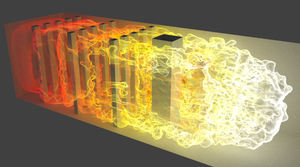C3U1 - Safety Applications: Large Eddy Simulation for Confined Explosions
The aim is to create and optimize an efficient workflow to simulate explosions in confined spaces using large eddy simulation.
Do you want to request support from EXCELLERAT staff or consulting on this Use Case?
*Registration is required to send inquiries.
This requires improvements in high-performance computing and mesh handling to improve user experience and time to solution.
Description - engineer
Safety applications represent an untapped potential for high-fidelity tools. The current state of the art relies mostly on experiments and on simple tools or correlations that have benefitted marginally from the advances in numerical simulation and computer science. Large-Eddy simulation (LES) is an advanced method and shows low-cost prediction capabilities compared to experimental investigations. The target setup in our case is the Sydney experiment [Kent, Masri et al, A new chamber to study premixed flame propagation past repeated obstacles, in: 5th Asia- Pacific Conference on Combustion, The University of Adelaide, Adelaide, Australia, 2005.]
A first research demonstration was performed using INCITE resources by Vermorel et al, [Combustion and Flame, 2017] using LES to reproduce and up-scale the geometry up to 24 times to match GexCon experimental studies. In this case, a 1 Billion element uniform mesh and up to 80 million Bluegene Q CPU hours were required. This use case aims to simplify and extend the AVBP code’s workflow to modern high-performance computing and automatic mesh refinement methods to reduce the computing requirement of such simulations by a factor of 10 rendering them cost-effective for the industrial design process.
Description - developer
AVBP has been developed since the late nineties and has achieved exceptional results for combustion simulations on gas turbines, piston engines and rocket propulsion simulations over several supercomputer generations. This feat is due to continuous technology watch, porting and performance efforts. Exascale computing is the occasion to tackle more complex systems and study even more complicated setups with massively different flow scales like explosions in confined spaces. To be able to simulate such cases, we must extend current workflows to handle dynamic, automatically optimized grids. For this use case, only tetrahedral Automatic Mesh Refinement will be considered. Of course, Efficient partitioning and load balancing are also compulsory.
This use case was developed within the EXCELLERAT P1 project phase.

